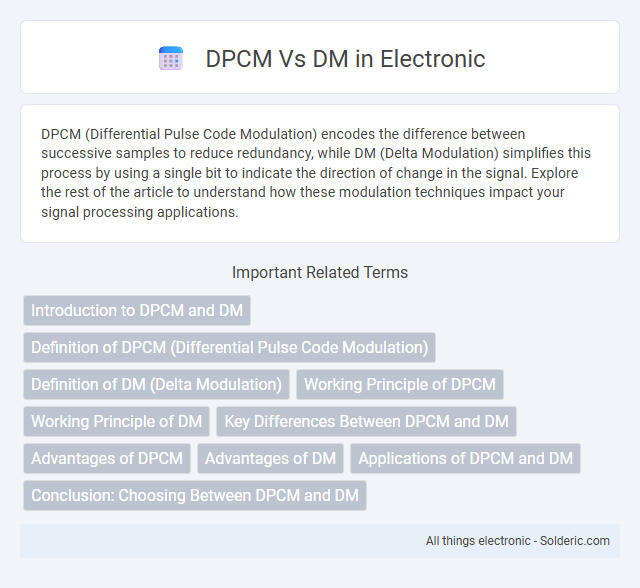DPCM (Differential Pulse Code Modulation) encodes the difference between successive samples to reduce redundancy, while DM (Delta Modulation) simplifies this process by using a single bit to indicate the direction of change in the signal. Explore the rest of the article to understand how these modulation techniques impact your signal processing applications.
Comparison Table
| Feature | DPCM (Differential Pulse Code Modulation) | DM (Delta Modulation) |
|---|---|---|
| Encoding Method | Difference between current and predicted sample quantized with multiple levels | Difference encoded with a 1-bit quantizer (up or down) |
| Quantization Levels | Multiple levels (multi-bit) | Two levels (1-bit) |
| Complexity | Higher; requires multi-level quantizer and predictor | Lower; simple comparator and integrator |
| Bit Rate | Moderate to high, depends on quantizer levels | Low, fixed 1 bit per sample |
| Signal Reconstruction | Better accuracy due to fine quantization | Less accurate; prone to slope overload and granular noise |
| Application | Speech and audio compression where moderate complexity is acceptable | Simple voice coding and low-bit-rate systems |
| Noise Performance | Lower quantization noise | Higher quantization noise, especially for rapidly changing signals |
Introduction to DPCM and DM
Differential Pulse Code Modulation (DPCM) and Delta Modulation (DM) are predictive encoding techniques used in digital signal processing to compress continuous signals. DPCM encodes the difference between the current and predicted signal values, improving efficiency by reducing redundancy in correlated data, while DM simplifies this approach by encoding only the sign of the difference, resulting in a one-bit output per sample. Both methods optimize bandwidth usage by leveraging signal prediction, with DPCM offering finer granularity and DM providing lower complexity.
Definition of DPCM (Differential Pulse Code Modulation)
Differential Pulse Code Modulation (DPCM) is a signal encoding technique that predicts the current sample based on the previous one and encodes only the difference, reducing the data rate compared to standard Pulse Code Modulation (PCM). Unlike Delta Modulation (DM), which encodes only the sign of the difference, DPCM captures both magnitude and direction, providing more accurate and efficient compression. Your choice between DPCM and DM depends on the balance you need between complexity and signal fidelity.
Definition of DM (Delta Modulation)
Delta Modulation (DM) is a method of analog-to-digital signal conversion that encodes the difference between successive samples rather than absolute values. It simplifies the encoding process by using a single bit per sample to represent whether the signal is increasing or decreasing, enabling efficient data compression. Compared to Differential Pulse Code Modulation (DPCM), which predicts the signal and encodes the prediction error with multiple bits, DM provides a more basic, low-complexity approach suitable for applications with limited bandwidth.
Working Principle of DPCM
Differential Pulse Code Modulation (DPCM) encodes the difference between successive samples rather than the samples themselves, reducing redundancy and improving compression efficiency compared to standard Pulse Code Modulation (PCM). In DPCM, each predicted sample is generated based on previous reconstructed samples, and only the prediction error is quantized and transmitted, minimizing the bitrate. Your audio or signal processing can benefit from DPCM by achieving higher compression without significantly compromising quality.
Working Principle of DM
The working principle of Desalination Membrane (DM) relies on semipermeable membranes that selectively allow water molecules to pass while rejecting salts and impurities, driven primarily by pressure differences. The process typically employs reverse osmosis, where hydraulic pressure forces seawater through the membrane, separating freshwater from dissolved solids. This membrane technology enables efficient extraction of clean water with high rejection rates of contaminants and minimal energy consumption compared to thermal methods.
Key Differences Between DPCM and DM
DPCM (Differential Pulse Code Modulation) compresses data by encoding the difference between successive samples, reducing redundancy and data size, while DM (Delta Modulation) encodes changes using a single bit per sample, representing only the increase or decrease in signal amplitude. DPCM typically offers better signal quality due to multi-bit quantization of differential signals, whereas DM is simpler and uses fewer bits but is more prone to granular noise and slope overload distortion. The choice between DPCM and DM hinges on a trade-off between complexity, bit rate, and signal fidelity in digital communication systems.
Advantages of DPCM
DPCM (Differential Pulse Code Modulation) offers improved compression efficiency by encoding the difference between successive samples, reducing redundancy compared to standard DM (Delta Modulation). Your audio or signal data benefits from better noise performance and higher quality reconstruction at lower bit rates. This makes DPCM especially advantageous in applications where bandwidth or storage is limited but fidelity must be preserved.
Advantages of DM
DM offers superior audio quality by directly manipulating individual digital samples, providing more precise control over the signal compared to DPCM's predictive approach. Your audio experience benefits from reduced quantization noise and improved dynamic range, making DM ideal for high-fidelity sound applications. Furthermore, DM's simpler decoder design enhances reliability and reduces latency in real-time audio processing.
Applications of DPCM and DM
DPCM (Differential Pulse Code Modulation) excels in applications involving audio and speech compression, where efficient encoding of signal differences reduces bandwidth without compromising quality. Delta Modulation (DM) is often applied in simple voice communication systems and telemetry due to its straightforward implementation and low computational requirements. Your choice between DPCM and DM depends on the need for either higher compression efficiency or system simplicity in signal processing.
Conclusion: Choosing Between DPCM and DM
Choosing between DPCM and DM depends on the specific requirements of your signal processing application, such as the desired balance between compression efficiency and complexity. DPCM is more suitable for applications needing moderate compression with simpler implementation, while DM provides higher granularity and better noise shaping for higher fidelity. Evaluating the trade-offs in terms of data rate, complexity, and distortion will guide your effective decision.
DPCM vs DM Infographic

 solderic.com
solderic.com